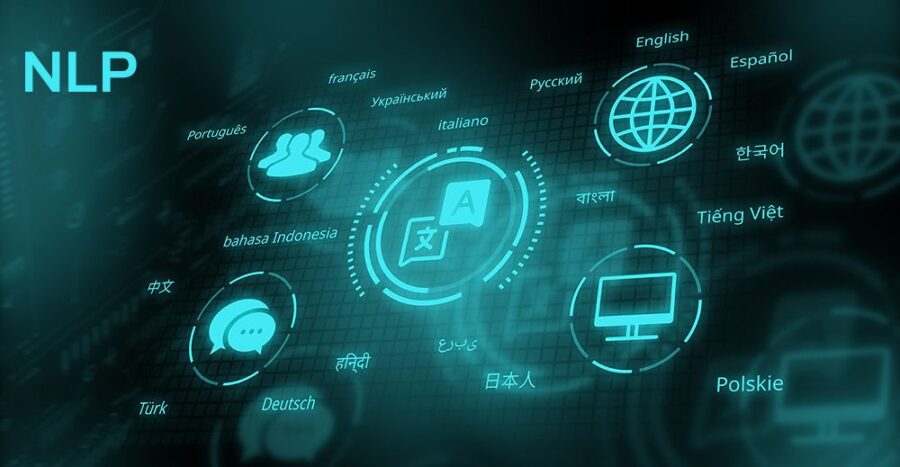
Natural language processing (NLP) is a discipline where machines are built with the main aim of manipulating human language or data resembling human language in the manner it is written, spoken and organized. It has originated from computational linguistics that makes use of computer science for understanding the principles of language. However, more than simply developing theoretical frameworks, NLP an an engineering discipline aimed at creating technology for accomplishing tasks that are useful. NLP is utilized quite often with speech recognition which is focused at parsing spoken language into words, converting sound to text and vice versa. Most NLP tasks translate human text and voice data in a way that it helps the computer in interpreting what it is taking in. NLP can be subdivided into two fields:-
i) Natural language understanding (NLU) – To understand the intended meaning behind a given text, semantic analysis is carried out;
ii) Natural language generation (NLG) – To focus on machine-generated text.
Natural language processing companies
NLP companies focus on NLP technology which involves the usage of computational algorithms and linguistic models for enabling machines to comprehend, analyze, and produce human language. These companies create software applications, tools, and services that utilize this technology to offer several language-related functions including speech recognition, sentiment analysis, language translation, chatbots as well as text analysis. NLP companies hire NLP experts, linguists, and software engineers to function together in developing and enhancing NLP algorithms and models. The services these companies offer are deployed in several industries including healthcare, finance, customer service, and marketing. They are utilized at an increasing pace for solving real-world issues in fields like social justice, climate change, and education.
Techniques in natural language processing
1. Speech recognition or speech to text: This is used to convert voice to text. It is needed in any application which takes voice commands or provides answers to spoken questions. Challenges in speech recognition is to do with the manner in which people talk – fast, mixing words together with varied stress and intonation in various accents through the use of incorrect grammar.
2. Part of Speech Tagging: This is also known as grammatical tagging. It involves identifying the part of speech of a given word or text as per usage and context. For example, part of speech helps in identifying the word ‘make’ as a verb in the sentence ‘I can make a paper plane,’ and as a noun in ‘What make of car do you own?’
3. Word sense disambiguation: This involves choosing the meaning of a word having more than one meaning using a process called semantic analysis. This helps in determining the word which makes the maximum sense in a given context.
4. Named entity recognition: This involves identifying words or phrases as useful entities. It is used for identifying ‘Kentucky’ as a location or ‘Sita’ as a woman’s name.
5. Co-reference resolution: This involves identification of two words that allude to the same entity. For example, figuring out the person or object which is referred to by a particular pronoun, ‘He’ = Paul. It also involves identification of a metaphor or an idiom in the text, like ‘bear’ referring to a person and not an animal.
6. Sentiment analysis: It is aimed at extracting subjective qualities which include attitudes, emotions, sarcasm, confusion, suspicion from the text.
7. Natural language generation: It involves allocating structured information into human language.
NLP has a promising future with scope for continuing advancements and innovations. Listed below are key trends and developments shaping its future.
1. Enhanced language models: NLP models like GPT-3 have shown great capabilities, however, one can surely hope to see much stronger models in the future who can gain a better understanding of the nuances of human language and produce text which is natural-sounding.
2. Multimodal NLP: This technology is seeing an expansion and includes other modalities like images and videos to enable machines to comprehend and produce content spanning various formats.
3. Personalized language models: With the increasing amount of data being generated, NLP models will be able to personalize content based on individual preferences and needs.
4. Enhanced language translation: There will be continuous improvement in language translations owing to the development of much more precise and context-aware translation models.
NLP can make a profound impact on the world in several ways. However, NLP is also at the heart of many controversies and acquiring a know-how of them is also a key duty of being a responsible practitioner. Hence, it’s clear from the insights shared above that NLP has a bright future and one can hope to witness many more innovative applications of this technology in the forthcoming years.
Summary: Natural language processing (NLP) is changing the manner in which we converse with one another as well as machines. However, NLP companies are not merely focused on creating products with commercial gains in mind.
